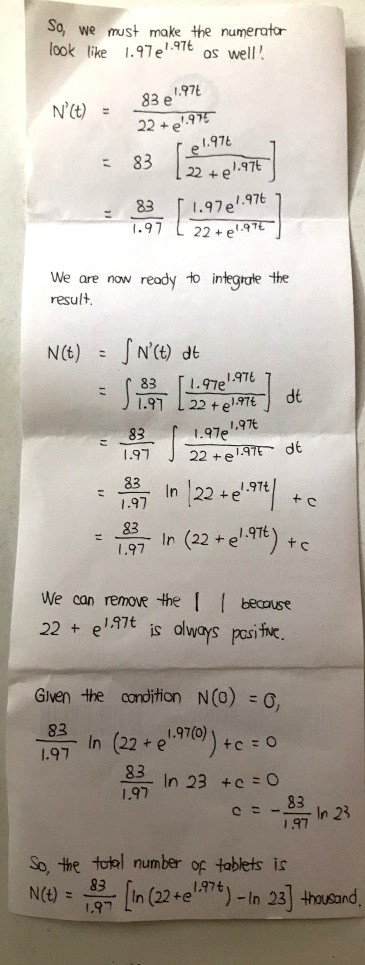Eric Nicholas K's answer to LockB's Junior College 1 H2 Maths Singapore question.
done
{{ upvoteCount }} Upvotes
clear
{{ downvoteCount * -1 }} Downvotes
Once you notice that the numerator is a constant multiplier of the derivative of the denominator, you know the form to take.
The weird numbers are reflective of what you can expect for Poly calculus courses.
The weird numbers are reflective of what you can expect for Poly calculus courses.
Date Posted:
1 year ago
why must we make the numberator 1.97e^1.97t when the derivative of the previous denominator is 1.97e^1.97t? i still dont understand how the concept works
When we differentiate (22 + e^1.97t), we get 1.97 times e^1.97t, correct?
This 1.97 times e^1.97t will form part of the numerator.
What happens when you differentiate ln (22 + e^1.97t)?
You get 1 divided by (22 + e^1.97t) times e^1.97t times 1.97 after completing the chain rule.
This can be written as [1.97e^1.97t] divided by [22 + e^1.97t].
--------------------------------------------------------
Reversing differentiation is essentially doing integration (or at least an anti-derivative), so in reverse, integrating [1.97e^1.97t] divided by [22 + e^1.97t] gets us ln (22 + e^1.97t) plus constant.
I intentionally manipulated the numerator to become 1.97e^1.97t for this very purpose.
The multiplier to the [1.97e^1.97t] divided by [22 + e^1.97t], which is basically the 83/1.97, will remain a multiplier 83/1.97 after the integration.
This 1.97 times e^1.97t will form part of the numerator.
What happens when you differentiate ln (22 + e^1.97t)?
You get 1 divided by (22 + e^1.97t) times e^1.97t times 1.97 after completing the chain rule.
This can be written as [1.97e^1.97t] divided by [22 + e^1.97t].
--------------------------------------------------------
Reversing differentiation is essentially doing integration (or at least an anti-derivative), so in reverse, integrating [1.97e^1.97t] divided by [22 + e^1.97t] gets us ln (22 + e^1.97t) plus constant.
I intentionally manipulated the numerator to become 1.97e^1.97t for this very purpose.
The multiplier to the [1.97e^1.97t] divided by [22 + e^1.97t], which is basically the 83/1.97, will remain a multiplier 83/1.97 after the integration.
Currently, the numerator 83e^1.97t does not achieve this yet.
Generally, if I can roughly see the "final integrated form" ahead (which in this case contains ln (22 + e^1.97t)), I will "pretend" this format to be "correct" and differentiate it first to see what the numerator should contain.
The numerator should contain 1.97e^1.97t as a result of this integration, but I see no 1.97 multiplier next to the e^1.97t.
This is why I rewrote 83 as 83/1.97 times 1.97, so that this "times 1.97" will adjoin to the e^1.97t and achieve what I wanted for the integration format.
The 83/1.97, on the other hand, will remain 83/1.97 throughout later on.
Generally, if I can roughly see the "final integrated form" ahead (which in this case contains ln (22 + e^1.97t)), I will "pretend" this format to be "correct" and differentiate it first to see what the numerator should contain.
The numerator should contain 1.97e^1.97t as a result of this integration, but I see no 1.97 multiplier next to the e^1.97t.
This is why I rewrote 83 as 83/1.97 times 1.97, so that this "times 1.97" will adjoin to the e^1.97t and achieve what I wanted for the integration format.
The 83/1.97, on the other hand, will remain 83/1.97 throughout later on.
So in short, you need to realise that the reverse of differentiation is obtaining an integral or at least an anti-derivative.
[The anti-derivative of a derivative does not contain "+c" unlike the integral of a derivative]
This very concept is useful as we try to shape our expression to look like the expression we wish to integrate later on.
[The anti-derivative of a derivative does not contain "+c" unlike the integral of a derivative]
This very concept is useful as we try to shape our expression to look like the expression we wish to integrate later on.
i kind of understand it now, but this takes alot of visualisation to do haha
will revisit this question again and try to redo
btw why is N(t) the expression for the total number of tablets manufactured at any time t? when N'(t) is the number of tablets im thousands produced per year
i dont really understand the relationship between N(t) and N'(t) - saw this in a few different question/context
will revisit this question again and try to redo
btw why is N(t) the expression for the total number of tablets manufactured at any time t? when N'(t) is the number of tablets im thousands produced per year
i dont really understand the relationship between N(t) and N'(t) - saw this in a few different question/context
also just to ask, does (xsinx) (-sinx) = - xsin^2x? or am i wrong
N’(t) is the rate of production, while N(t) is the actual number of tablets at that time.
Think of N’(t) as speed. It’s kind of your instantaneous speed at time t.
Think of N(t) as total distance. Your speed might change over time, but there will always be a value for the total distance travelled from t = 0 to time t.
Think of N’(t) as speed. It’s kind of your instantaneous speed at time t.
Think of N(t) as total distance. Your speed might change over time, but there will always be a value for the total distance travelled from t = 0 to time t.
(x sin x) (-sin x) is simply -x sin^2 x
thanks! i managed to get the answer after redoing it. do we have to do it the same why when we see any exponential fractions?
also for the removal of |.. | in ln|..... |, is it because e^1.97t will always be a positive value as anything to the power of smth will always yield a positive number, and including + 22, it will be guaranteed that 22+e^1.97t will always be positive?
also for the removal of |.. | in ln|..... |, is it because e^1.97t will always be a positive value as anything to the power of smth will always yield a positive number, and including + 22, it will be guaranteed that 22+e^1.97t will always be positive?
In general, for any integral of the format f’(x) / f(x), I usually try to look out for situations where the numerator is a constant multiple of the derivative of the denominator. It doesn’t just apply to exponentials only, of course.
Let’s say the denominator is x^3 + 2x^2 + 5. Its derivative is 3x^2 + 4x, so I will try and look out for the denominator to see if it is 3x^2 + 4x itself or things like 6x^2 + 8x and so on. If they meet the format, I try and make sure my fraction meets the format nicely.
The |…| can be removed in the case where the content is always positive, as is the case with this exponential expression with a minimum value exceeding 22.
Let’s say the denominator is x^3 + 2x^2 + 5. Its derivative is 3x^2 + 4x, so I will try and look out for the denominator to see if it is 3x^2 + 4x itself or things like 6x^2 + 8x and so on. If they meet the format, I try and make sure my fraction meets the format nicely.
The |…| can be removed in the case where the content is always positive, as is the case with this exponential expression with a minimum value exceeding 22.



